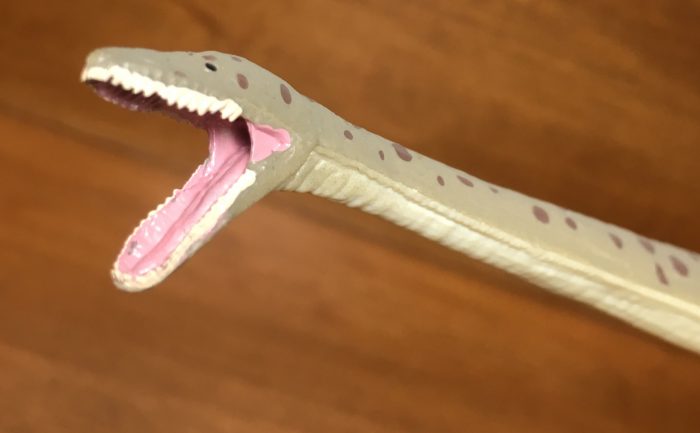Thalassomedon, the “sea lord” plesiosaur, inhabited Late Cretaceous seas some 95 million years ago. A close cousin of Elasmosaurus, it may have used its long neck to slowly sneak up on schools of fish or squid before before spearing a victim with its needle-like teeth.

This rendition of Thalassomedon was released in the summer of 2016. Measuring some 33 cm long from the tip of its muzzle to the end of its short tail, it is one of CollectA’s longest Deluxe figures. That said, more than half of that length is taken up by the neck, thus making this one of the smallest Deluxes at the same time. It also has a flipperspan of 10.5 cm.

As a child, nearly all my dinosaur books depicted elasmosaurs as having fantastically flexible necks that could twist and bend and coil. However, we now know that their necks had a relatively limited range of motion. Thalassomedon couldn’t rapidly strike out at its prey like a viper, nor could it raise its head high like a swan while swimming at the ocean surface. As such, this figure’s neck is held almost completely straight out in front, with the head turned very slightly to the left. The mouth is wide open, as though the predator is about to snap up a tasty fish or some other small morsel. The most popular proposed method of feeding for elasmosaurs seems to be the one I mentioned in the introduction, but there are a number of other highly intriguing ideas outlined on this fine website.

The main colours on the Thalassomedon are beige on top and white on bottom. The entire upper half of the body is speckled with medium brown spots. The teeny, tiny eyes are black, the mouth is pink, and the teeth are eggshell white. All in all, it’s hardly what you’d call an exciting ensemble, but it works well for a marine animal. It’s strongly reminiscent of the colour scheme found on harbour seals.

The Thalassomedon‘s skin has a lightly wrinkled texture all over. The flippers are stout and muscular and the small, sharp teeth lining the mouth are very well-sculpted. The inside of the mouth features a long, narrow tongue and ridges on the palate. The short tail features a small fluke near the tip. No soft tissue of Thalassomedon has been discovered just yet, but tail flukes have been confirmed on its relatives Cryptoclidus and Pantosaurus. Indeed, paleontologists might argue that the fluke should extend out from the underside of the tail as well. The only real inaccuracy on this toy then is that the left front flipper appears to be angled forward beyond the range of motion on the real animal. The flippers are also slightly upturned due to warping.

In conclusion, I find the CollectA Thalassomedon to be a very fine toy, one of the best elasmosaur representations to date, and well worth the purchase.

Disclaimer: links to Ebay and Amazon on the DinoToyBlog are affiliate links, so we make a small commission if you use them. Thanks for supporting us!




[…] you can pose it in a swan-like fashion, or you can pose it in a more accurate straight pose akin to CollectA’s Thalassomedon. The head of this model is accurate to the photos I have seen of the skull, if a little cartoony, […]
I agree with you Suspsy is a great toy and at the same time a beautiful reproduction for those of us collectors. From my point of view Urge on the part of Collecta and other companies that continue making more sea reptiles of the elasmosaurido family and also urges on the part of Collecta to do Deluxe figures of the family of ichtyosauridos that unfortunately to date have not done. For example a shonisaurus that replaces that of Schleich or a temnodontosaurus would be necessary.